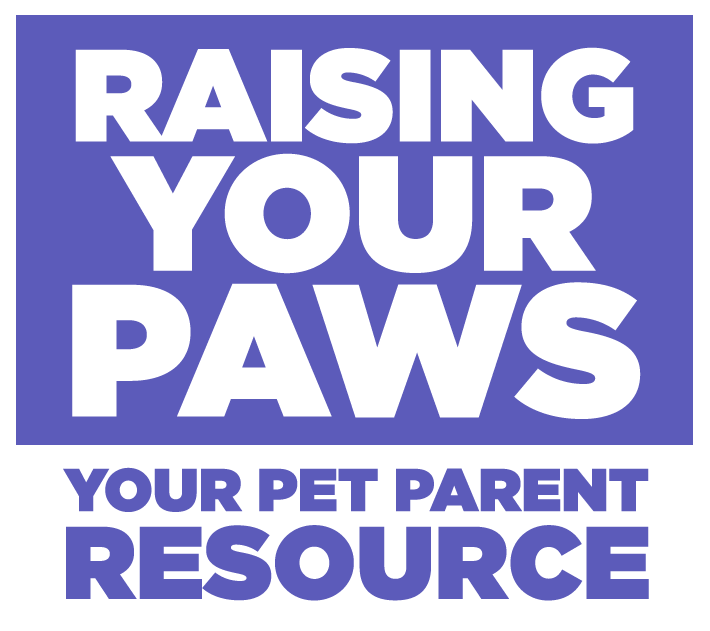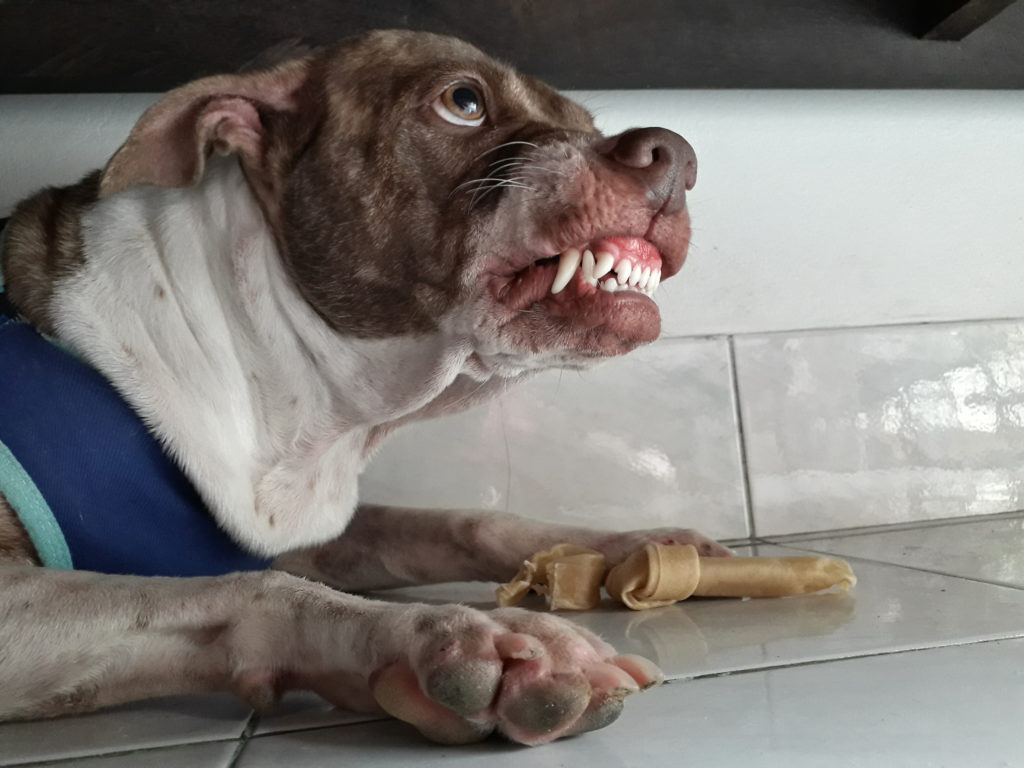One of the major reasons people get bitten by dogs they know, has to do with something the canines inherited from their wolf ansestors – the response to having to compete with others.
In competition for resources such as food or territory with other wild animals, wolves use a series of ritualized body postures, facial and vocal signals to communicate their willingness and intent to become aggressive, if need be, before they actually do, in the hope that their warning will be heeded by potential adversaries. The goal of those signals is to keep food for themselves, or protect their territory, or drive a competitor away, without having to resort to actual combat, which is a risky physical confrontation that can endanger the animal’s health and life.

Your dog has the same inherited behaviors and survival strategies that wolves do to deal with competition which means they can become aggressive to keep or protect “things” and also use the same warning signals before taking it to the next level. Not all dogs react the same way. Some dogs I know are very laid back, and don’t care if another dog takes their toy or a person takes food out of their mouths. Others may get aggressive with strangers but not with familiar people or animals. Rosy doesn’t get triggered around her dog friends, but this fall, a new unfamiliar puppy got too close when she was grabbing clumps of mud to eat from the ground and she went into resource guarding mode, and pounced on the smaller dog. Yah, I know….over mud? I can’t explain it.
So what does this have to do with the danger of us getting bitten? Even though this may not make sense to you, some times, dogs can percieve you as being the one they are competing with for something they want – like keeping the hotdog they stole from the kitchen counter, or the rancid chicken bone they found along their walk, or your child’s favorite toy they picked up.
Naturally, you want to take these things away from the dog, because, they need to learn not to jump on kitchen counters, or you don’t want them eating street garbage or your child is crying because the doggy has its stuffed animal. But you need to be aware that a problem can arise unexpectedly, if your dog REALLY wants to hang on to the object and if you go to take it from them, from their point of view, you are not the friendly, human they normally love, but are now a competitor for the resource and their instinct can kick in and the dog may be willing to fight for it. You and I know, that you are not taking that moldy piece of bread garbage, out of its mouth so that you can eat it, but your dog does not know that. They just know that you want to get what they have and some dogs will respond negatively to it. And to make it even more confusing, the aggressive response may be inconsistant, it can depend upon how high of value the item has to the dog.
I can take bread out of Rosy’s mouth that she finds on the street without any incident, but I did not try to grab the rotisserie chicken carcass out of her jaws after she snatched it out of the waste basket and was running away from me. I quickly got a metal pot from the kitchen and threw it over the chicken thereby separating it from her and then drew her away from it and then restrained her so I could go and pick up the bones. I was not about to take the chance to see if my normally sweet, easy going canine would get all physical with me over that huge prize.
In the past episode of the podcast, (ep. 83) I was talking to dog aggression expert, Bryan Bailey, and the author of the book, “The Hammer: Why Dogs Attack Us and How To Prevent It.” about the top reasons people get bitten, and how dog’s always use certain signals to warn others that they may become aggressive. This is good news for all of us. We can learn to anticipate a possible bite.
The bite does NOT come out of nowhere – from “out of the blue.” Your dog does warn you. But we mostly don’t see it or know that we have been notified of impending aggression. To prevent getting bitten or attacked in these cases you’ve got to learn to watch for and recognize the signs dogs are using to tell you a bite or attack may be coming.

Besides the slightly raised lip, this dog is using four other warning signs to communicate, “back away from my chew toy or I may have to get physical with you to keep it.” Do you know what they are?
There are 5 subtle warning signals your dog uses first, to tell you to back off.
Look at these parts of your dog’s body and what it is doing, that will clue you in to an impending bite or attack.
1. The body or torso. It becomes stiff or rigid.
2. The lips. The lip is raised perhaps showing some teeth and the snout may be wrinkled.
3. The eyes. A dog looks at you out of the corner of their eye revealing the white part. It’s called the “crescent moon” because this is the shape of the white part of the eye you can see. The eyes may also show a hard stare – sometimes described as “lifeless” eyes.
4. The ears. They suddenly moved back and downward.
5. The tail. It rises as fully high as it can go or drops down below the parallel line of the dog’s body.
All of these signs and signals are used by canines towards any other animals, dogs and cats that might threaten them.

Note the crescent moon shape of the white part of the dog’s eye and the ears pinned back. This dog is communicating possible aggression towards this cat.

Notice the high tail position. This dog is also showing its teeth but may not always exhibit both signs at the same time.

Notice the base of the tail that falls below the parallel line of the dog’s back. This may occur without the more obvious barking and showing of teeth.
Here is an example of how competition leading to aggression could play out between you and your pooch.
Your dog is lying on the floor, happily chewing on a new bone that you gave him as a special gift. You figure the dog has had it long enough and its time for you to put it away. You get up and start walking towards your dog. Your dog is on to you – in his mind – just your approach towards him demonstrates your obvious intent to take the prized bone away. He does not know that you don’t want to eat it yourself or that he’ll be getting it back, later on. In your dog’s eyes, you may have just become a competitor for this highly valued item and since it dog, desperately wants to keep the bone to himself, but also wants to avoid physical contact with you, he will begin to systematically display the warning signals going from the more subtle ones to the increasingly ferocious ones, if needed. He’s telling you, it’s MINE, you can’t have it and you’d better back off and go away or I might have to fight you for it.
Make the decision that it’s not worth the possibility of getting bitten and use a different strategy to get the chew away from your dog. I always trade Rosy, getting some small pieces of cheese (high value for her) and then dropping one piece at a time, about a foot away and in an opposite direction from where she leaves the bully stick for a moment to eat the cheese. Then on the third time, as she is distracted eating the cheese, I pick up the stick. No harm, no foul.
If the subtle signals don’t work to make an opponent stop and back away, a dog will raise the stakes and display increasingly more aggressive actions. These are the more noticeable and dramatic behaviors you expect from dogs.
- A deep growl, with fangs exposed.
- When guarding a valued item, the dog may straddle the object and increase the viciousness of the growl. You may notice your dog, simply hunching over an item if they remain lying down.
Any additional advance on your part towards the dog after seeing these last two signs, will most likely result in an attack.
You don’t even have to have the intent to take away an item, for your dog to feel threatened. In the first year I had Rosy, one evening, when friends were over, one of them got up from the couch and walked close by to Rosy, who was lying on her mat, gnawing on a dried beef tendon. Rosy started stiffening and growling at her as she got closer and closer to her. Ivy veered off somewhat and Rosy, calmed down when she realized Ivy didn’t want her treat whenever she walked near her – she was only on her way to the kithen or bathroom.
By not noticing or ignoring the signs and signals of impending aggression from our canines – we inadvertantly may continue behavior, that gets us and the dogs into trouble. It can be the person or child who reaches out their arm and hand over the dog’s head to pat them, even though the dog is moving away from them, while stiffening their body or the person who continues to approach the animal to take the item away even though the dog’s ears move back and shows the whites of the eyes.
Do yourself and your pet a big favor and start watching for what your dog is telling you. By paying attention to this language of dogs, and responding in ways that will alleviate the conflict instead of increasing it, you can help protect yourself and others from dog bites that occur, all too often, from ALL sizes and breeds of dogs.
In this week’s episode 84, below, find out how a dog can quickly switch from defending an object to thinking they need to defend themselves and why this becomes so deadly. Most importantly, you’ll hear what to do to survive if you are attacked by a dog.




Hi I am 74 years young my daughter got a rescue dog 6 mos. Of age now 2 years old. She got the dog when she was going through Breast Cancer. The dog is extremely attached to her watches every move and checks on her whatever she is doing. We do not know exactly how she was treated during the 1st. 6 mos. She sleeps with her and won’t let me near the bed barking and starring me straight in my eyes like she might attack. I can feed her and scratch her behind her ears for a while, play with a ball outside then she’ll start to starr at me mostly in the house I look away she stops but my daughter has also had to grab her by her collar and I leave. My daughter says I’m to timid and I should show her who’s boss but she scares me. She is a Shallie her breed is Shepard and border collie. She is a Beautiful dog, Shepard face with hair like a border collie. Now my daughter broke her ankle and I am at her home a lot taking care of her. She really scares me she has killed a couple of rabbits that came in the yard. Can you help me?? Ive been reading but no luck on how to handle this situation. I really don’t know what I do that triggers her agression. Thank you.
Hi Janet, First, the fact that she is a good hunter and is killing rabbits, is simply natural, canine, predatory behavior and is no indication of possible aggression towards you or humans. Don’t worry about that. Regarding the way she does act in the house towards you, is of concern. I think you are right to be cautious right now. I understand your fear and undoubtedly, this is a difficult situation -needing to take care of your daughter but fearing getting bit. The key is, as you write, that you don’t really know what she is reacting to or why? I think what is going to be best and needed now, is having someone come in to observe exactly what the dog is doing in relation to you. I recommend either a Veterinary Behaviorist, (they specialize in aggression issues,) or an animal behavior consultant. I am adding links to their websites, where you can find out about them and locate someone near you. Often, you can call for a consultation to get started and decide if someone needs to come to the house. Here is the link for Vet. Behaviorists. https://www.dacvb.org/ Here is the one for behavior consultants. https://m.iaabc.org/ Thank you for writing me. Please keep me informed after you contact a professional. You can write me at susan@raisingyourpaws.com.